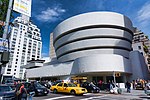National Academy of Design
1825 establishments in New York (state)23rd Street (Manhattan)Academies of artsArt museums and galleries in New York CityArt museums established in 1825 ... and 12 more
Art schools in New York CityClubs and societies in New York CityDesign museums in New York (state)Fifth AvenueLearned societies of the United StatesMuseums in ManhattanNational Academy of DesignNational Academy of Design peopleOrganizations established in 1825Upper East SideUse mdy dates from December 2018Venetian Gothic architecture in the United States

The National Academy of Design is an honorary association of American artists, founded in New York City in 1825 by Samuel Morse, Asher Durand, Thomas Cole, Martin E. Thompson, Charles Cushing Wright, Ithiel Town, and others "to promote the fine arts in America through instruction and exhibition." Membership is limited to 450 American artists and architects, who are elected by their peers on the basis of recognized excellence.
Excerpt from the Wikipedia article National Academy of Design (License: CC BY-SA 3.0, Authors, Images).National Academy of Design
East Drive, New York Manhattan
Geographical coordinates (GPS) Address Nearby Places Show on map
Geographical coordinates (GPS)
| Latitude | Longitude |
|---|---|
| N 40.784 ° | E -73.959 ° |
Address
East Drive
East Drive
10128 New York, Manhattan
New York, United States
Open on Google Maps







